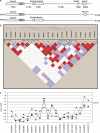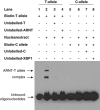A common polymorphism in the cannabinoid receptor 1 (CNR1) gene is associated with antipsychotic-induced weight gain in Schizophrenia
- PMID: 20107430
- PMCID: PMC3055343
- DOI: 10.1038/npp.2009.235
A common polymorphism in the cannabinoid receptor 1 (CNR1) gene is associated with antipsychotic-induced weight gain in Schizophrenia
Abstract
Antipsychotic-induced weight gain has emerged as a serious complication in the treatment of patients with atypical antipsychotic drugs. The cannabinoid receptor 1 (CNR1) is expressed centrally in the hypothalamic region and associated with appetite and satiety, as well as peripherally. An antagonist of CNR1 (rimonabant) has been effective in causing weight loss in obese patients indicating that CNR1 might be important in antipsychotic-induced weight gain. Twenty tag SNPs were analyzed in 183 patients who underwent treatment (with either clozapine, olanzapine, haloperidol, or risperidone) for chronic schizophrenia were evaluated for antipsychotic-induced weight gain for up to 14 weeks. The polymorphism rs806378 was nominally associated with weight gain in patients of European ancestry treated with clozapine or olanzapine. 'T' allele carriers (CT+TT) gained more weight (5.96%), than the CC carriers (2.76%, p=0.008, FDR q-value=0.12). This translated into approximately 2.2 kg more weight gain in patients carrying the T allele than the patients homozygous for the CC genotype (CC vs CT+TT, 2.21+/-4.51 vs 4.33+/-3.89 kg; p=0.022). This was reflected in the allelic analysis (C vs T allele, 3.84 vs 5.83%, p=0.035). We conducted electrophoretic mobility shift assays which showed that the presence of the T allele created a binding site for arylhydrocarbon receptor translocator (ARNT), a member of the basic helix-loop-helix/Per-Arnt-Sim protein family. In this study, we provide evidence that the CNR1 gene may be associated with antipsychotic-induced weight gain in chronic schizophrenia patients. However, these observations were made in a relatively small patient population; therefore these results need to be replicated in larger sample sets.
Figures

 , genotypic
, genotypic  and haplotypic
and haplotypic  (three marker sliding window) analyses between the SNPs and antipsychotic-induced weight gain. The SNP rs806378 shows both allelic and genotypic association whereas rs9450902 and rs10485170 show only allelic association. The color reproduction of this figure is available on the html full text version of the manuscript.
(three marker sliding window) analyses between the SNPs and antipsychotic-induced weight gain. The SNP rs806378 shows both allelic and genotypic association whereas rs9450902 and rs10485170 show only allelic association. The color reproduction of this figure is available on the html full text version of the manuscript.
Similar articles
-
Association of a functional polymorphism in neuropeptide Y with antipsychotic-induced weight gain in schizophrenia patients.J Clin Psychopharmacol. 2013 Feb;33(1):11-7. doi: 10.1097/JCP.0b013e31827d145a. J Clin Psychopharmacol. 2013. PMID: 23277265
-
Endocannabinoid Pro129Thr FAAH functional polymorphism but not 1359G/A CNR1 polymorphism is associated with antipsychotic-induced weight gain.J Clin Psychopharmacol. 2010 Aug;30(4):441-5. doi: 10.1097/JCP.0b013e3181e742c5. J Clin Psychopharmacol. 2010. PMID: 20631561
-
Association study between variants of AMP-activated protein kinase catalytic and regulatory subunit genes with antipsychotic-induced weight gain.J Psychiatr Res. 2012 Apr;46(4):462-8. doi: 10.1016/j.jpsychires.2012.01.010. Epub 2012 Feb 2. J Psychiatr Res. 2012. PMID: 22305490
-
Genetic dissection of atypical antipsychotic-induced weight gain: novel preliminary data on the pharmacogenetic puzzle.J Clin Psychiatry. 2001;62 Suppl 23:45-66. J Clin Psychiatry. 2001. PMID: 11603885 Review.
-
Antipsychotic induced weight gain: genetics, epigenetics, and biomarkers reviewed.Curr Psychiatry Rep. 2014 Oct;16(10):473. doi: 10.1007/s11920-014-0473-9. Curr Psychiatry Rep. 2014. PMID: 25138234 Review.
Cited by
-
The Complex Relationship between Antipsychotic-Induced Weight Gain and Therapeutic Benefits: A Systematic Review and Implications for Treatment.Front Neurosci. 2018 Jan 22;11:741. doi: 10.3389/fnins.2017.00741. eCollection 2017. Front Neurosci. 2018. PMID: 29403343 Free PMC article. Review.
-
Pharmacogenetic Associations of Antipsychotic Drug-Related Weight Gain: A Systematic Review and Meta-analysis.Schizophr Bull. 2016 Nov;42(6):1418-1437. doi: 10.1093/schbul/sbw058. Epub 2016 May 23. Schizophr Bull. 2016. PMID: 27217270 Free PMC article.
-
Natural products proposed for the management of Huntington's disease (HD): a comprehensive review.Naunyn Schmiedebergs Arch Pharmacol. 2025 Jul 17. doi: 10.1007/s00210-025-04444-w. Online ahead of print. Naunyn Schmiedebergs Arch Pharmacol. 2025. PMID: 40676294 Review.
-
Alterations to melanocortinergic, GABAergic and cannabinoid neurotransmission associated with olanzapine-induced weight gain.PLoS One. 2012;7(3):e33548. doi: 10.1371/journal.pone.0033548. Epub 2012 Mar 16. PLoS One. 2012. PMID: 22438946 Free PMC article.
-
Pharmacogenetics of response to antipsychotics in patients with schizophrenia.CNS Drugs. 2011 Nov 1;25(11):933-69. doi: 10.2165/11595380-000000000-00000. CNS Drugs. 2011. PMID: 22054119 Review.
References
-
- Aberle J, Fedderwitz I, Klages N, George E, Beil FU. Genetic variation in two proteins of the endocannabinoid system and their influence on body mass index and metabolism under low fat diet. Horm Metab Res. 2007;39:395–397. - PubMed
-
- Barrett JC, Fry B, Maller J, Daly MJ. Haploview: analysis and visualization of LD and haplotype maps. Bioinformatics. 2005;21:263–265. - PubMed
-
- Basile VS, Masellis M, De Luca V, Meltzer HY, Kennedy JL. 759C/T genetic variation of 5HT(2C) receptor and clozapine-induced weight gain. Lancet. 2002;360:1790–1791. - PubMed
Publication types
MeSH terms
Substances
Grants and funding
LinkOut - more resources
Full Text Sources
Other Literature Sources
Medical
Molecular Biology Databases

